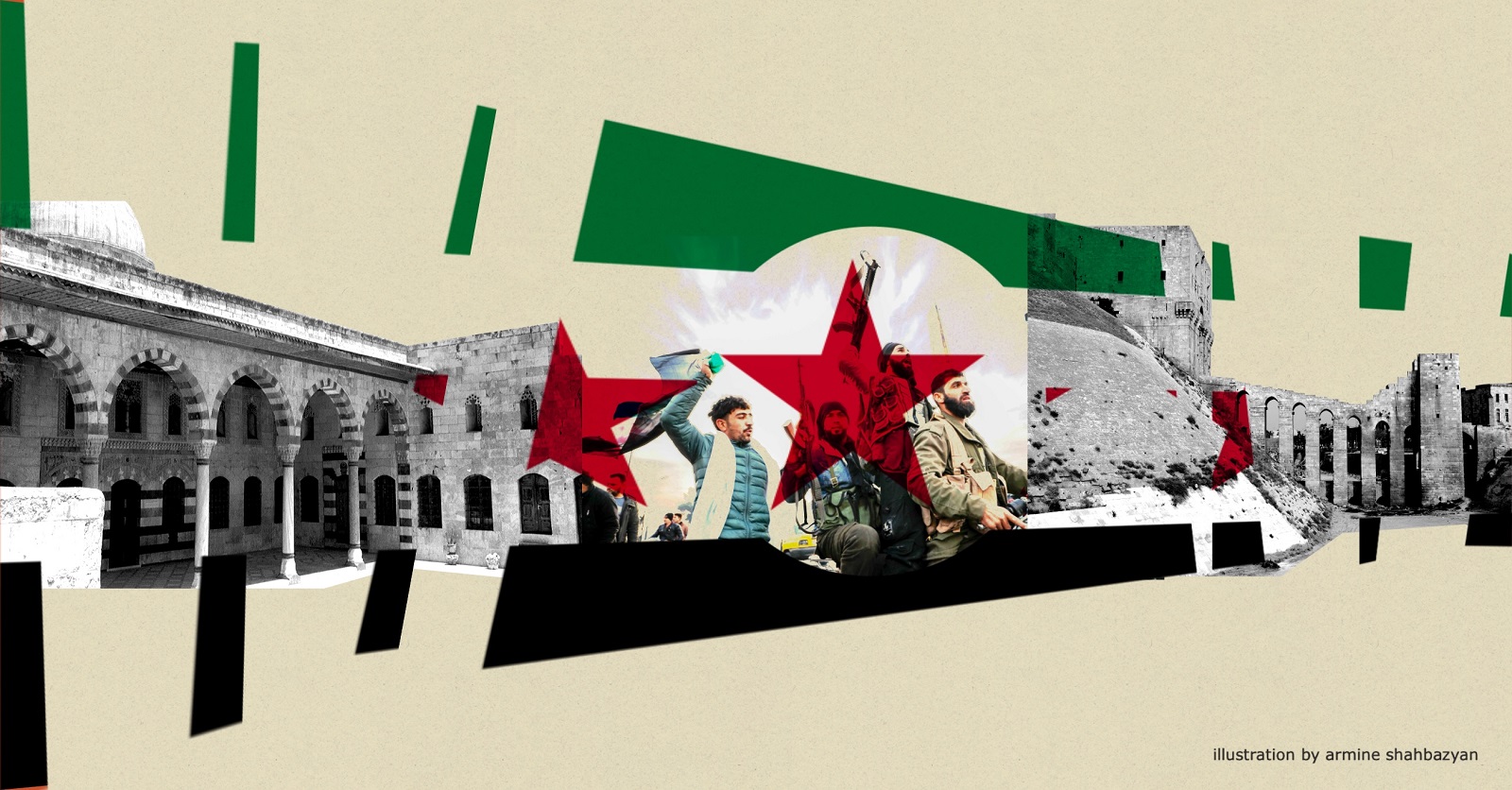
Listen to the article.
The rapid advance of the Hayat Tahrir al-Sham (HTS) rebels, supported by Turkey, across Aleppo, Hama, Homs and Damascus toppled the Assad dynasty’s grip on Syria in just 12 days––ending a regime that had ruled the country with an iron fist since 1970.
Syria’s political landscape is transforming at breathtaking speed. While historical opposition groups and countless refugees welcome this development, the Syrian war remains far from resolved. The Alawite, Christian, Ismaili, and—to a lesser extent—Druze minorities watch with caution.
Abandoned by his Russian and Iranian allies, Bashar al-Assad has fallen victim to the broader consequences of the Ukraine war and Israel’s conflict following the October 7, 2023, massacre. His army, drained by 13 years of civil war and riddled with corruption, proved incapable of holding ground without Hezbollah, Shia militias, and Russia’s critical support.
The weakest link in the Shia axis of resistance failed to recover from a decade of international economic sanctions and its shift toward captagon drug production, which operated like a criminal enterprise.
After rejecting Ankara’s calls for normalization talks, Bashar al-Assad faced an unanticipated reality: he had to accept the federalization of his country. This path follows a 2017 Russian constitutional proposal. The plan would create autonomous zones in the north for Ankara-backed groups and Kurdish forces, while granting special status to the regime’s Alawite coastal stronghold.
Today, the fears of a worst-case scenario may potentially unfold before our eyes: Syria’s disintegration and developments mirroring post-Gaddafi Libya. The state has fragmented into several autonomous factions engaged in intermittent wars over resources, compounded by an inevitable confrontation between the Sunni majority and Alawite, Kurdish and Druze minorities.
Understanding Turkey’s Role
Turkey, through President Recep Tayyip Erdogan, has reluctantly acknowledged its involvement, after initially seeking to advance a narrative that it had no substantive engagement with the rebel offensive. The aftermath of October 7, 2023, presented an opportunity to shift the status quo in its favor: a Russia overwhelmingly preoccupied with Ukraine, Iran subjected to Israel’s decimation of its proxies and a United States happy to see Turkey take the lead in Syria. Presumably for the Americans, who maintain military presence in eastern and central Syria, a regime change would have entailed at least some guarantees that the new government would pose no threat to Israel. Israel used the regime’s collapse to extend control over the eastern Golan Heights, establishing a secure buffer zone.
Aleppo and its region will likely become economically and politically tied to Turkey—perhaps under a hybrid status similar to Northern Cyprus, which Turkish troops have occupied since 1974. This model has proven effective in Syrian territories already under Turkey’s direct or indirect control. Turkey leverages two powerful tools: pan-Turkism through its support of Syrian Turkmen militias, and pan-Islamism by backing a Damascus government likely influenced by the Syrian Muslim Brotherhood. These developments heightened concerns among Aleppo’s dwindling Christian population and other minorities, who valued Assad’s relatively tolerant approach to minority groups.
Why the Worst Is Yet to Come
The Assad regime, abandoned by its Russian ally on both northern and southern fronts, appears to be the victim of a Russo-Turkish agreement—reminiscent of Moscow’s betrayal of Artsakh, where it sacrificed its Armenian ally for geostrategic interests. While Russia might attempt to maintain its bases in the Alawite-majority coastal zone, it cannot stabilize Syria alone. The various rebel factions advancing on Damascus shared only one common goal: toppling Bashar al-Assad.
HTS, the latest incarnation of Al-Qaeda’s Syrian branch and its jihadists, will inevitably clash with Islamic State fighters who are reemerging in eastern Syria. Meanwhile, the Kurdish-led Syrian Democratic Forces remain defiant following Bashar’s departure.
This looming chaos mirrors the fall of Saddam Hussein in Iraq in 2003. Minorities find themselves without any protector to safeguard their lives and property. While HTS militants are currently making reassuring gestures toward Christians and Armenians in Aleppo, these communities remain uncertain because they were caught off guard by both the swift advance and the collapse of loyalist forces.
The local Armenians, many of whom hold Armenian citizenship, are perplexed by the Armenian government’s failure to provide adequate communication and coordination with the community, particularly following the decision to hastily evacuate the staff of the Armenian embassy in Damascus. A country perceived as close to Iran and Russia, two powers that sponsored the Assad regime, one can easily understand this decision.
Adding to their concern, they recall that some of the jihadists now in Aleppo previously served as mercenaries in Azerbaijan, “hunting Armenians.” While it should be noted here that the mercenaries guilty of atrocities against Armenians in 2020 came from the ranks of the Syrian National Army, a pro-Turkish organization that rivals HTS, the presence of Turkmen militants in Aleppo won over by the pan-Turkist ideology raises legitimate concerns.
In response to the crisis, the Catholicos of the Great House of Cilicia, Aram I, has disbursed emergency food aid to families who have lost their livelihoods to rampant inflation—a step that, while necessary, remains insufficient.
What will become of Aleppo’s Armenian community—the cradle of the post-1915 diaspora—with its priceless heritage of institutions, churches and libraries if it faces a status similar to that under Ottoman rule? And what will be the fate of the Armenians of Kessab, the oldest Armenian village outside of the homeland?
Despite assurances from the new authorities to Aleppo and Damascus’s Christian communities, looting has already begun. In Damascus, for instance, certain neighborhoods were ransacked on the night of December 7–8 as news of the regime’s fall spread. Security and stability will be severely tested as rival rebel factions inevitably clash for power. This raises fears of a scenario similar to post-Saddam Iraq, where Christians became frequent targets of terrorist groups through attacks, kidnappings for ransom, assaults on women, and assassinations.
Syria is poised to become a new epicenter of jihad, drawing thousands of recruits from across the globe seeking to make their “hijra.” From Yerevan’s perspective, the urgent question now is how to organize the evacuation of our compatriots, leveraging support from the UN and diplomatic representations operating in Syria.
[Beyond Borders]
Column
Crisis in Georgia: What It Means for Armenia’s EU Ambitions
As Georgia grapples with political turbulence and debates its path toward the European Union, its future will inevitably influence Armenia. Meanwhile, Georgia’s recent history in navigating relations with the West offers valuable lessons that Armenia might consider for its own journey.
Read moreWhat Does a Second Trump Presidency Mean for Armenia?
Donald Trump's return to the U.S. presidency may not bode well for Armenia. Yet, it is a reality beyond its control, demanding clear-eyed pragmatism to preserve and build upon the hard-won partnership cultivated in recent years.
Read moreEVN Security Report
EVN Security Report: November 2024
Looking at the emerging contours of the Trump Doctrine and its implications for the South Caucasus, Nerses Kopalyan examines competing policy orientations within Trump's incoming administration and how these will shape U.S. engagement with Armenia amid broader global and geopolitical priorities.
Read more




